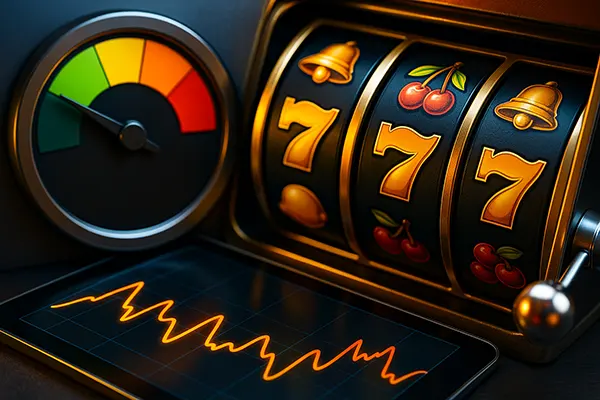
Slot Volatility Analysis: How to Assess Risk Before You Start Playing
Volatility is one of the most important aspects to consider when choosing a slot game. While themes, graphics, and bonus features may catch the eye, it’s the volatility that determines how often and how much a player can potentially win. In this article, we’ll break down what volatility really means, how to identify it, and what kind of slot behaviour it indicates, helping players make informed decisions based on their personal risk tolerance and goals.
Understanding Slot Volatility
Slot volatility, also known as variance, refers to the risk level of a particular game. It describes how frequently a slot is likely to pay out and the size of those wins. High-volatility games pay out less often but offer larger potential rewards. Low-volatility games offer smaller, more frequent payouts, providing a steadier but less thrilling experience.
Volatility is not usually displayed directly in the slot’s description, which means players often have to make educated assumptions based on certain indicators. These include the size of the top prize, the frequency of bonuses, and the payout percentage. Understanding these signs helps predict how a slot is likely to behave over time.
It’s important to note that volatility doesn’t affect the Return to Player (RTP) rate. Two games may have identical RTPs but offer entirely different experiences due to differences in volatility. While RTP gives an average over a long period, volatility tells you what to expect in the short term.
Indicators of High or Low Volatility
High volatility slots typically feature large maximum wins, often exceeding 5,000x the stake. These games often include progressive jackpots, rare bonus rounds, and multipliers. Players may experience long dry spells without wins, followed by potentially big payouts.
In contrast, low volatility slots tend to feature frequent winning combinations, even if the amounts are small. These games are ideal for players looking for entertainment and longer sessions without depleting their balance too quickly.
Game providers sometimes give clues through the theme and bonus mechanics. Games with cascading reels, expanding wilds, and free spins with multipliers often lean towards high volatility. On the other hand, classic fruit machines or slots with few bonus features often signal low volatility.
How to Evaluate Slot Volatility in Practice
One of the simplest methods to estimate volatility is by playing the game in demo mode. Observing the frequency and size of wins during a sample session provides a practical sense of the game’s risk profile. If the wins are rare but large, the slot likely has high volatility. If wins occur frequently but are modest, it’s probably a low-volatility game.
Another effective method is to examine the paytable. A wide gap between high and low symbol payouts usually signals high volatility. Conversely, a flatter paytable with smaller differences between symbols may suggest lower volatility.
Additionally, players can research user reviews and expert opinions. Forums and communities often discuss game behaviour and may reveal consensus about a slot’s volatility. While this is anecdotal, it complements direct observation and paytable analysis for a fuller picture.
Volatility Ratings and Developer Information
Some game developers explicitly provide volatility ratings. These may appear as low, medium, or high labels, or even as numerical scales (e.g. 1 to 5). This is particularly helpful for players unfamiliar with analysing slot mechanics independently.
Well-known developers like NetEnt, Play’n GO, and Pragmatic Play often maintain consistency in their game designs. For example, Play’n GO frequently develops medium-to-high volatility slots, while older NetEnt titles may skew towards medium variance.
However, even when developers provide a volatility indicator, it should be used alongside other tools like demo play and paytable analysis. Developers’ definitions of “medium” or “high” can vary, and player experience may differ depending on individual play sessions.

Matching Volatility with Personal Preferences
Choosing the right volatility level depends on your personal goals. High-volatility games are better suited to players with larger bankrolls or those seeking big, rare wins. These players must be comfortable with risk and patient enough to endure longer losing streaks.
Low-volatility slots are ideal for casual players or those with smaller budgets. The frequent small wins help extend playtime and maintain engagement, even without the excitement of major payouts. They’re great for entertainment and bonus wagering requirements.
Medium-volatility slots offer a balanced approach. These games deliver a mix of frequent wins and occasional larger payouts, making them suitable for most players. They provide variety without the extremes of low or high variance slots.
Bankroll Management Strategies
Understanding volatility allows players to plan their sessions more effectively. High-volatility games require a larger bankroll and conservative bet sizing to withstand periods without wins. Setting session limits helps avoid overspending during unlucky runs.
For low-volatility games, players can afford slightly higher bet sizes or longer sessions, since the risk of rapid losses is lower. However, it’s still essential to track spending and stop when a pre-set loss limit is reached.
Volatility awareness also helps when chasing promotions or fulfilling wagering requirements. In such cases, low-to-medium volatility games are often preferred due to their steadier win patterns and lower risk of early balance depletion.
